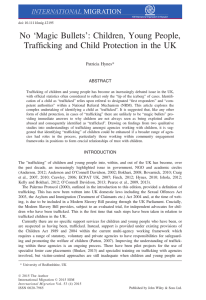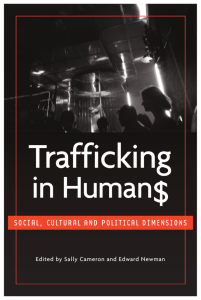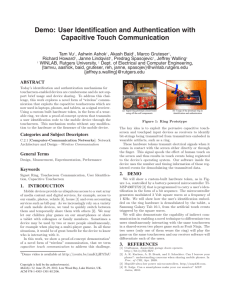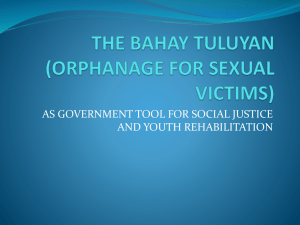Special Section: Developing Frameworks for the Protection of ficked Persons Traf
advertisement
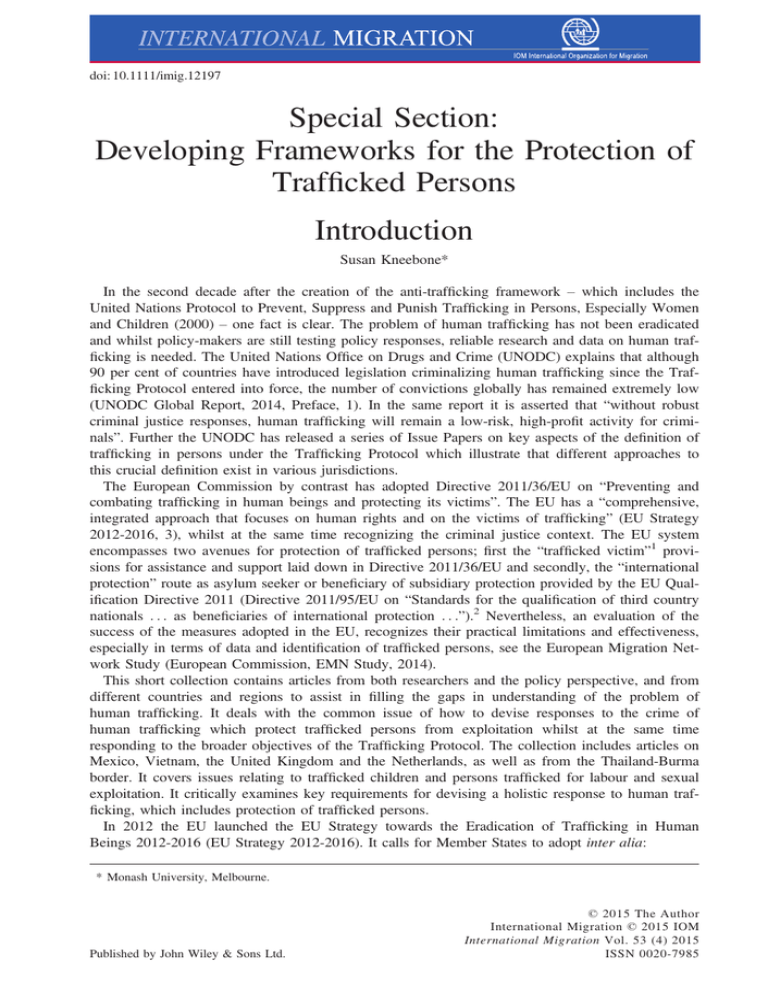
doi: 10.1111/imig.12197 Special Section: Developing Frameworks for the Protection of Trafficked Persons Introduction Susan Kneebone* In the second decade after the creation of the anti-trafficking framework – which includes the United Nations Protocol to Prevent, Suppress and Punish Trafficking in Persons, Especially Women and Children (2000) – one fact is clear. The problem of human trafficking has not been eradicated and whilst policy-makers are still testing policy responses, reliable research and data on human trafficking is needed. The United Nations Office on Drugs and Crime (UNODC) explains that although 90 per cent of countries have introduced legislation criminalizing human trafficking since the Trafficking Protocol entered into force, the number of convictions globally has remained extremely low (UNODC Global Report, 2014, Preface, 1). In the same report it is asserted that “without robust criminal justice responses, human trafficking will remain a low-risk, high-profit activity for criminals”. Further the UNODC has released a series of Issue Papers on key aspects of the definition of trafficking in persons under the Trafficking Protocol which illustrate that different approaches to this crucial definition exist in various jurisdictions. The European Commission by contrast has adopted Directive 2011/36/EU on “Preventing and combating trafficking in human beings and protecting its victims”. The EU has a “comprehensive, integrated approach that focuses on human rights and on the victims of trafficking” (EU Strategy 2012-2016, 3), whilst at the same time recognizing the criminal justice context. The EU system encompasses two avenues for protection of trafficked persons; first the “trafficked victim”1 provisions for assistance and support laid down in Directive 2011/36/EU and secondly, the “international protection” route as asylum seeker or beneficiary of subsidiary protection provided by the EU Qualification Directive 2011 (Directive 2011/95/EU on “Standards for the qualification of third country nationals . . . as beneficiaries of international protection . . .”).2 Nevertheless, an evaluation of the success of the measures adopted in the EU, recognizes their practical limitations and effectiveness, especially in terms of data and identification of trafficked persons, see the European Migration Network Study (European Commission, EMN Study, 2014). This short collection contains articles from both researchers and the policy perspective, and from different countries and regions to assist in filling the gaps in understanding of the problem of human trafficking. It deals with the common issue of how to devise responses to the crime of human trafficking which protect trafficked persons from exploitation whilst at the same time responding to the broader objectives of the Trafficking Protocol. The collection includes articles on Mexico, Vietnam, the United Kingdom and the Netherlands, as well as from the Thailand-Burma border. It covers issues relating to trafficked children and persons trafficked for labour and sexual exploitation. It critically examines key requirements for devising a holistic response to human trafficking, which includes protection of trafficked persons. In 2012 the EU launched the EU Strategy towards the Eradication of Trafficking in Human Beings 2012-2016 (EU Strategy 2012-2016). It calls for Member States to adopt inter alia: * Monash University, Melbourne. Published by John Wiley & Sons Ltd. © 2015 The Author International Migration © 2015 IOM International Migration Vol. 53 (4) 2015 ISSN 0020-7985 4 Kneebone 1 A systematic approach to victim identification, protection and assistance (Strategy Priority A), 2 A more diverse group of actors than before in policymaking (Strategy Priority D) inter alia police officers, border guards, immigration and asylum officials, public prosecutors, lawyers, members of the judiciary and court officials, housing, labour, health, social and safety inspectors, and Civil Society Organizations, 3 Formal, functional national referral mechanisms (NRMs) describing procedures to better identify, refer, protect and assist victims and including all relevant public authorities and civil society (Strategy Priority A – Action 1) (EMN Study, 2014, 30). The articles in this collection provide examples which endorse these recommendations. Victoria Rietig, “Prevent, Protect, and Prosecute Human Trafficking in Mexico: Policy and Practical Recommendations” deals with the broad framework for tackling human trafficking. Rietig highlights the need for greater cooperation and coordination between actors in anti-trafficking, which draws upon the obligations in Part III of Trafficking Protocol. Part III (“Prevention, cooperation and other measures”) is aimed at reducing vulnerability factors of “victims of trafficking” and their potential for “revictimization”. It is thus linked to the obligation to protect trafficked persons (Kneebone and Debeljak, 214-217). Importantly, the obligation to cooperate includes with civil society (Trafficking Protocol, Articles 9(3) and 10(2)). But as Rietig’s analysis shows, antitrafficking measures are ineffective where systems supported by the rule of law are absent and cooperation is lacking. Drawing on the results from a field research project conducted in 2012 in Mexico, Rietig’s findings identify many challenges to anti-trafficking which suggest absence of the rule of law including: corruption, lack of funds and lack of knowledge of relevant stakeholders, ineffective cooperation between actors and violence. According to Rietig, interviewees highlighted the need for more reliable data and statistics, technical assistance, training of dedicated officials, and rationalization of roles to avoid duplication. Rietig concludes with eight recommendations which include: Increased cooperation across sectors (both public and private) and designing an anti-trafficking platform, increasing trust in the legal system and promoting human trafficking on the political agenda. Her findings are consistent with the 2014 US State Department TIP Report on Mexico which found that: The Government of Mexico does not fully comply with the minimum standards for the elimination of trafficking . . . . It was difficult to assess government efforts to identify and assist victims and to investigate and prosecute trafficking cases, as data collection on victim identification and law enforcement efforts was uneven. Official complicity continued to be a serious problem. Government funding for specialized victim services and shelters remained inadequate . . . . Victim identification and interagency coordination remained weak in many parts of the country. The political, regional and cultural context is an underlying sub-text of Rietig’s analysis. Mexico is indeed a major country of origin, transit and destination of trafficked persons. The majority of the migrants and trafficking victims come from Central America and are destined to go to the United States (Talsma, 2012). As many of the victims are trafficked for labour exploitation, Rietig suggests that the range of actors involved in anti-trafficking be extended to unions and workers. Hoang’s analysis of the broad policy response to trafficking in Vietnam (Hoang, Thi Tue Phuong “Protection for Trafficked Persons in Viet Nam: Another National Security Discourse?”) also demonstrates the need for a coherent framework supporting both prevention and protection. Hoang describes how in Vietnam’s legal system, human trafficking is understood in a sexualized discourse as a “social evil”, which extends the meaning of national security. Under Vietnam’s legal system © 2015 The Author. International Migration © 2015 IOM Introduction 5 trafficked persons are treated as tools of the criminal legal system in prosecutions against traffickers and may be subject to status-related offences. In particular, Hoang explains that under this discourse trafficking for labour exploitation, which is a major issue in Vietnam, is not seen as an issue of human trafficking. Hoang’s analysis shows that the specific terms of the legal definition are vital to identification of trafficked persons. Moreover, as explained below, in Vietnam identification of trafficked persons is very dependent on local officials who oversee the system of household registration. Her findings thus support the need for a coherent anti-trafficking framework and holistic approach to prevention and protection. Sarah Meyer, Courtland Robinson, and Michele R. Decker, in their article “Trafficking, exploitation and migration on the Thailand-Burma border: a qualitative study”, build upon some of the ideas in Hoang’s analysis of the policy framework in Vietnam. This article presents findings from in-depth interviews with 61 migrant workers living and working in and around Mae Sot, Thailand, on the Thailand-Burma border. Its significance is twofold; first, it describes the multiple phases of the trafficking process and potential risks at each phase – including recruitment, travel and transit, and exploitation at destination. It thus tracks the three components of the Trafficking Protocol definition : namely acts, means and exploitation. The results of the study show that there is often substantial overlap between the process (acts), means, and end exploitation. For example, the process of recruitment may include use of force or threat. On the other hand, at destination migrant workers are often exposed to a range of exploitative experiences, including violence, coercion, and economic exploitation. In particular the article highlights the use of debt to leverage compliance. A second important finding of this study is that human trafficking for the purpose of “labour exploitation”, or exploitation in the context of labour, exists in migration on the Thailand-Burma border. The results of the study demonstrated that use of transporters (“carries”) and brokers in order to travel to Thailand and find employment can result in trafficking into sex or labour exploitation. As the authors state: “Globally, lack of access to safe and legal ways for low-skilled workers to migrate have resulted in individuals entering into arrangements that result in trafficking.” A similar point is made by Hoang in relation to Vietnam. These first three articles demonstrate the need to have broader understandings of the trafficking and migration processes and the type of exploitative experiences that amount to human trafficking. As all the authors recognize, this requires that a broader range of actors be involved in prevention of human trafficking. This is especially the case if trafficking is understood to arise in a broad range of exploitative situations. The evidence presented in these articles also suggests that a legal and policy framework supported by the rule of law, and an appropriate definition and understanding of trafficking, need to be in place to create a “systematic approach to victim identification, protection and assistance” (EU Strategy 2012-2016). The remaining two articles focus on the issue of trafficking of children from two different perspectives; the policy-maker and the researcher. The article by Moira Galloway, Monika Smit and Mariska Kromhout, “Between Control and Support – The Protection of Unaccompanied Minor Asylum Seekers at Risk: the Dutch Case” describes a Dutch government project to protect Unaccompanied Minor Asylum Seekers (UMAs) who were perceived to be at risk of becoming victims of human trafficking, by implementing “Protected Reception”. This initiative is an example of the EU “international protection” route identified above, and involves a “proactive” procedure for identification of trafficked persons. Both the Czech Republic and the Netherlands have implemented separate identification and referral processes for children in pursuance of EU policy under Directive 2011/36/EU (Article 15). The article by Galloway et al. describes the evolution and modification of the specialized reception facility for UMAs provided by the Dutch government. As the article explains, although the project was successful on one level in apparently protecting a vulnerable group by disrupting their © 2015 The Author. International Migration © 2015 IOM 6 Kneebone onward movement, it raised the important tension between protection and prevention, between the rights of vulnerable persons and state objectives. The authors raise the question of how far a state can go in protecting vulnerable young people, by limiting their freedom of movement. In other contexts it has been found that shelters for trafficked persons (mainly young people) are used as a form of detention (Gallagher and Pearson, 2010). But the success of the project suggests that “Protected Reception” acted as a “circuit breaker” in the relationship (or potential relationship) between a young person and trafficker. The young people placed in protected reception procedures received sustained psychological assessment and support. This is important, as it documented that trafficked children often identify with and “bond with” the perpetrator of their exploitation. For example a study by Gozdziak of children trafficked into the US found that 83% were aged between 14-17 years and that a number of the “victims” were not discontented and did not want to be “rescued” (Gozdziak 2008, 904). The article by Patricia Hynes, in “No ‘Magic Bullets’: Children, Young People, Trafficking and Child Protection in the UK” highlights the vulnerability of young people in exploitative situations. Hynes deals squarely with the issue of identification of trafficked children in the UK and the complexity of this issue in the context of the UK’s NRM, and the overlap with other form of child protection. Drawing on findings from two qualitative studies into understandings of trafficking amongst agencies working with children, it is suggested that identifying “trafficking” of children could be enhanced if a broader range of agencies had roles in the process, particularly those working within community engagement frameworks who are in positions to form crucial relationships of trust with children. The article highlights the lack of specific support services for children and young people who have been, or are suspected as having been, trafficked into the UK. Instead, support is provided under existing child protection legislation within a multi-agency working framework, which requires a range of statutory, voluntary and private agencies to have responsibilities for safeguarding and promoting the welfare of children. Hynes’ article on the UK explains that anti-trafficking efforts run parallel to a broader immigration and asylum agenda that has seen an increasing tightening of policy and legislation since the mid-1990s, and that such anti-immigration policy clouds the identification of trafficked persons. Meyer et al. also highlight that the anti-trafficking context is often irregular migration across borders. Hoang describes this context as one of “border security and anti-migration discourse”. As stated in Evaluation of the Effectiveness of Measures for the Integration of Trafficked Persons: The major barrier in dealing with trafficking is the same whether considered from the data, criminology, immigration, human rights or integration perspective, and thus relating to prevention, prosecution and protection: it is the identification of victims . . . (Van Selm 2013, 17). All three objectives of the EU Strategy 2012-2016 converge on the issue of identification (Strategy Priority A). For example, it is stated that there is a need for “formal procedures to better identify, refer, protect and assist victims” (Strategy Priority A – Action 1), but that this must occur in the context of a “more diverse group of actors” (Strategy Priority D). In Vietnam for example, Hoang explains that identification of victims is a difficult issue in the context of the household registration system, which operates at the local level, and which is dependent upon the action of local officials who for various reasons do not report the presence of victims. Indeed the evidence suggests that in many countries where formal mechanisms for identification are lacking or are inappropriate,3 that non-governmental organisations are filling the gap. In Vietnam, Blue Dragon has been instrumental in identifying and supporting young people trafficked from central Vietnam to Ho Chi Minh City for exploitative labour (Kneebone et al. and Blue Dragon, 2014). Other organizations assist with the identification and support of trafficked women (Kneebone et al. and SHARE, 2015). From her study of the UK system, Hynes concludes © 2015 The Author. International Migration © 2015 IOM Introduction 7 that the identification of children or young people as trafficked could be enhanced by a multiagency framework, in which non-statutory agencies have a stronger role in the NRM process. In particular, she argues that minority ethnic, and migrant and refugee community organizations who work within such populations in the UK, are well-placed both to raise awareness about trafficking and to form crucial relationships of trust with children within communities. Thus, she suggests, they could assist in the identification of trafficked children and in collection of information surrounding the circumstances in which children are trafficked to the UK. In its report, the EMN stresses the need for proactive “methods of detection” such as the screening of all applicants for international protection, training of case workers, and provision of information to facilitate self-reporting (EMN Study 2014, 5). It also found that migrants were less likely to be proactively screened in forced return procedures (EMN Study 2014, 7). Yet it also concluded that: Authorities in forced return procedures seem to play a bigger role in official identification of victims than the authorities in international protection procedures. This is because authorities implementing forced return are usually necessarily law enforcement officers, and so they also have the power to investigate crime (including trafficking) (EMN Study 2014, 7). These observations highlight the dilemma of having multiple opportunities to identify trafficked persons without the support of clear avenues of referral. They also suggest that the methods of criminal investigators need to be learned by a broad range of actors at first instance. Despite there being no express requirement to identify trafficked persons, such an obligation can be sheeted home to a state’s basic Prevention and Protection obligations, which require that traffickers and trafficked persons be identified. The obligation to identify trafficked persons does not begin and end with the receiving state. Identification of trafficked persons is a precursor to cooperation between states as required under Part III of the Trafficking Protocol (Kneebone and Debeljak, 2012, 224-225) and should be a key feature of anti-trafficking strategies. ACKNOWLEDGEMENTS This collection of articles is an outcome of a project supported by the Australian Research Council (ARC); LP0990168, “Delivering Effective Protection to Victims and Prevention of Human Trafficking in the Greater Mekong Sub-Region”. The support of the ARC is gratefully acknowledged. The articles arise from papers presented at two Panels organized by Susan Kneebone at the conference of the International Association for the Study of Forced Migration held in Kolkata, India in January 2013. NOTES 1 The term “victims of trafficking” is used in deference to the views of policy-makers and consistency with the Trafficking Protocol, although it is suggested that “trafficked persons” is a more neutral term which recognises the agency of such persons. 2 The Qualification Directive is part of the Common European Asylum System (CEAS) - a series of Directives dealing with Reception of Asylum Seekers, Procedures for the Grant and Withdrawal of Refugee Status, Temporary Protection, and Returns 3 For example, in Vietnam most identification takes place at the border and so persons who self-return may not be “officially” identified. See Hoang, Thi Tue Phuong, unpublished PhD thesis, 2012, copy on file. © 2015 The Author. International Migration © 2015 IOM 8 Kneebone REFERENCES European Commission 2014 Identification of victims of trafficking in human beings in international protection and forced return procedures: European Migration Network Study, information at < http://ec.europa.eu/dgs/homeaffairs/what-we-do/networks/european_migration_network/reports/docs/emn-studies/emn_synthesis_ identification_victims_trafficking_final_13march2014.pdf >, viewed 25 May 2015 (EMN Study 2014). 2012 The EU Strategy towards the Eradication of Trafficking in Human Beings 2012-2016, COM(2012) 286 final, information at < http://ec.europa.eu/home-affairs/doc_centre/crime/docs/trafficking_in_ human_beings_eradication-2012_2016_en.pdf>, viewed 25 May 2015 (EU Strategy 2012-2016). Gallagher, A.T., and E. Pearson 2010 “The High Cost of Freedom: A Legal and Policy Analysis of Shelter Detention for Victims of Trafficking”, Human Rights Quarterly, 32(1): 73. Gozdziak, E. 2008 “On Challenges, Dilemmas, and Opportunities in Studying Trafficked Children”, Anthropological Quarterly, 81(4): 903–924. Kneebone, S., and J. Debeljak 2012 Transnational Crime and Human Rights: Responses to Human Trafficking in the Greater Mekong Subregion, Routledge. Kneebone, S., Yea, S., and Ligam, M. with Blue Dragon Children’s Foundation 2014 Child Labour From Hue to Sai Gon, Vietnam. Copy on file. Kneebone, S., Yea, S., Ligam, M. and Kenny, J.with Luu, T.L., To, T H., Nguyen, T.C. from Counselling, Research and Life Psychology (SHARE) 2015 Psychological and social measures for survivors of trafficking in Vietnam. Copy on file. Talsma, L. 2012 ‘Human Trafficking in Mexico and Neighbouring Countries: a review of protection approaches’ New Issues in Refugee Research, Research Paper No. 229 (UNHCR). United Nations 2000 Protocol to Prevent, Suppress and Punish Trafficking in Persons, especially Women and Children, Supplementing the United Nations Convention Against Transnational Organized Crime, opened for signature 15 November 2000, 2237 UNTS 319 (entered into force 25 December 2003) (‘Trafficking Protocol’), information at <http://treaties.un.org/Pages/ViewDetails.aspx?src=TREATY&mtdsg_no=XVIII-12-a&chapter=18&lang=en>, viewed 25 May 2015. United Nations Office on Drugs and Crime (UNODC) 2014 Global Report on Trafficking in Persons information at http://www.unodc.org/documents/data-andanalysis/glotip/GLOTIP_2014_full_report.pdf , viewed 25 May 2015. US State Department 2014 Trafficking In Persons Report, Mexico, information at <http://www.state.gov/j/tip/rls/tiprpt/countries/2014/226777.htm>, viewed 20 May 2015. Van Selm, J. 2013 Evaluation of the Effectiveness of Measures for the Integration of Trafficked Persons (IOM). © 2015 The Author. International Migration © 2015 IOM
